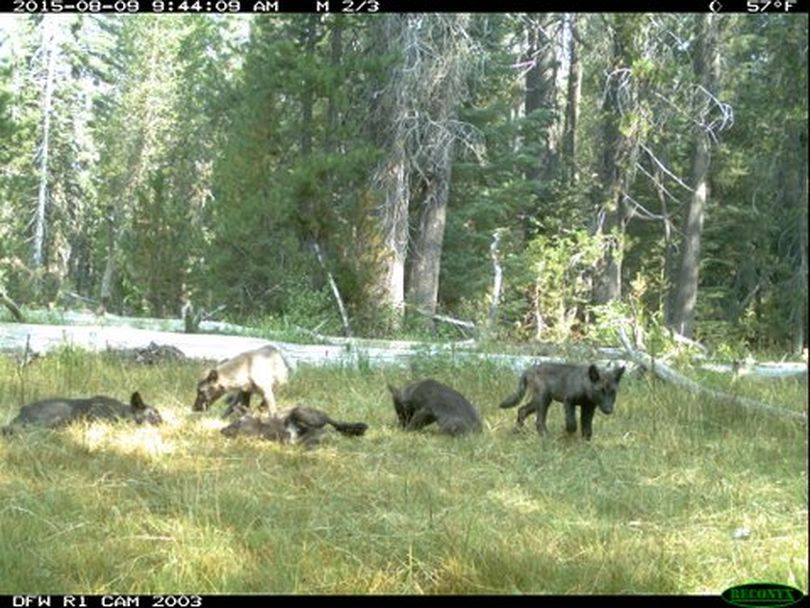Photos confirm California’s first wolf pack in nearly a century

ENDANGERED SPECIES -- The Oregon wolf, OR-7, first explored the landscape in California in 2011-2012 and now the first settlers have moved into Siskiyou County.
The California Department of Fish and Wildlife released remote camera images last week as evidence of five gray wolf pups and two adults in Northern California.
The first wolf pack documented in California in nearly a century has been named the Shasta Pack for its proximity to the prominent Cascades volcano.
After trail cameras recorded a lone canid in May and July, CDFW deployed additional cameras, one of which took multiple photos showing five pups, which appear to be a few months old and others showing individual adults. Because of the proximity to the original camera locations, it is likely the adult previously photographed in May and July is associated with the group of pups, officials said.
“This news is exciting for California,” said agency Director Charlton H. Bonham in a statement. “We knew wolves would eventually return home to the state and it appears now is the time.”
Indeed the news was greeted with enthusiasm by wildlife advocates, but also with concern by hunters and livestock producers:
- “This is an Endangered Species Act success story in the making,” Pamela Flick, with the Defenders of Wildlife conservation non-profit, told the San Jose Mercury Times.
- “If the public wants wolves maybe they should support the people that are helping feed the wolves,” Jim Rickert, who owns a ranch nearby, told the Sacramento Bee.
Wild wolves historically inhabited California, but were extirpated. Aside from these wolves and the famous wolf OR7 who entered California in December 2011, the last confirmed wolf in the state was here in 1924. OR7 has not been in California for more than a year and is currently the breeding male of the Rogue Pack in southern Oregon.
In June 2014, the California Fish and Game Commission voted to list gray wolves as endangered under the California Endangered Species Act. The gray wolf is also listed as endangered in California, under the Federal Endangered Species Act of 1973. Gray wolves that enter California are therefore protected by the ESA making it illegal to harass, harm, pursue, hunt, shoot, wound, kill, trap, capture or collect wolves, or to attempt to engage in any such conduct in California.
State wildlife officials are completing a Draft Wolf Management Plan and will release it soon on its Gray Wolf webpage. It's being hammered out with participation of many stateholders, as was the case with Washington's 2011 Gray Wolf Management Plan.
Though wolves rarely pose a direct threat to human safety, CDFW is recommending that people never approach, feed or otherwise disturb a wolf.
The state is posting on its website answers to Frequently Asked Questions.
Trail cameras first spotted a suspected gray wolf in May and June and biologists set out to retrieve scat samples and set up additional cameras, wildlife authorities said. Two adult wolves were then captured on film. The whole pack was confirmed on Aug. 9.
The adult wolves are suspected to be from Oregon but wildlife authorities do not believe they are descended from OR-7, the one that wandered into California in 2011. DNA samples have been sent to a lab in Idaho to determine the clan's origin.
“We’re very interested in where did these wolves come from and who did they descend from,” Kovacs told the Sacramento Bee.
